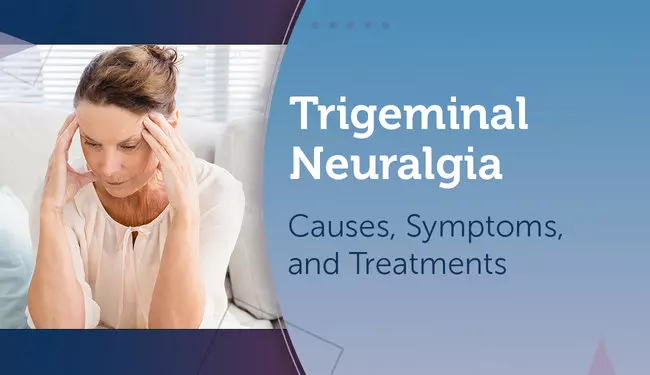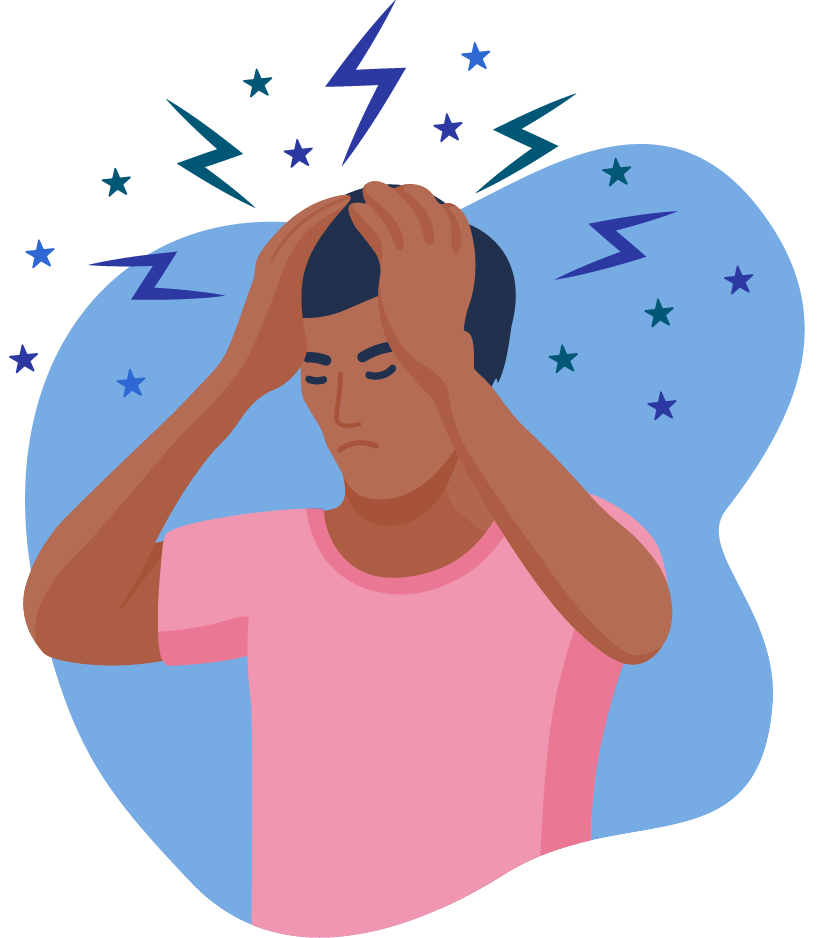
Quick Links
Resources
About MyMigraineTeam
Powered By






Trigeminal neuralgia (TN), sometimes called tic douloureux (painful tic), is a chronic pain condition that causes severe pain in the face. TN is considered a rare disease and usually occurs in people over age 50, with a higher prevalence among women. Approximately 150,000 new cases of TN are diagnosed each year. TN can cause debilitating pain that may have a serious impact on quality of life, but it is not a life-threatening disease.
TN is a disorder of the trigeminal nerve — the fifth cranial nerve, located in the head — which affects the skin, tendons, muscles, teeth, and mucous membranes of the face. Dysfunction of the trigeminal nerve occurs in most forms of migraine. People with migraines have an increased risk of TN, particularly those who have subtypes of migraine with aura.
Although many researchers believe the condition manifests as one disease across a single spectrum, TN is sometimes designated as two distinct types:
The cause of TN is not fully understood. Researchers believe that the trigeminal nerve can become compressed by pressure from blood flow through abnormal blood vessels, which damage the protective myelin sheath of the nerve. When damage to the trigeminal nerve cannot be detected, the condition is sometimes called idiopathic TN.
Secondary TN (also called symptomatic TN) can occur due to another underlying condition affecting the trigeminal nerve. The myelin sheath of the nerve may become damaged by multiple sclerosis (MS), which causes demyelination of nerves. MS is the most common cause of secondary TN. In rare occurrences, secondary TN can be caused by damage to the nerve by a tumor, surgery, trauma to the face, or stroke.
When the trigeminal nerve is damaged, it can become hyperactive and cause heightened sensitivity throughout different regions of the face. There are three branches of the trigeminal nerve that each affect a different region of the face. TN can occur in more than one region at a time but usually affects only one side of the face:
The middle and lower branches of the nerve are more commonly affected by TN. When the nerve is hypersensitive, pain signals can be spontaneously triggered by contact with the face or vibration that affects the face. Light touching and basic activities such as eating, talking, shaving, or brushing teeth can cause intense shocks of pain. Hot and cold beverages can also aggravate the nerve in TN, as well as exposure to wind.
TN causes severe nerve pain that is often described as a sharp, shooting, or stabbing pain. It is sometimes described as an electric shock-like pain and is most commonly experienced in the cheek and jaw. It can come on suddenly or start with a tingling, aching, or burning sensation that turns into abrupt, short bursts of pain that come and go. Each burst of pain usually lasts sometime between a few seconds and a few minutes.
When the condition is flaring, short attacks of pain may last longer, become more frequent, or cause continuous pain. Pain may be located in one particular spot, or cover a wider region of the face. During a flare, pain attacks may last for weeks or months. Some people with TN experience pain-free intervals between flare-ups. Those with continuous pain may experience an ongoing dull ache in between flares.
Other common symptoms of TN include:
The extreme sensitivity caused by TN can cause secondary problems, such as disturbance of sleep and avoidance of social contact, due to depression, anxiety, and pain.
Extreme, short bursts of facial pain that are unilateral — on one side of the face — are often indicative of TN. A diagnosis of TN is based on several criteria:
MRI can indicate secondary causes of TN, such as an MS lesion or a tumor, but MRI cannot always detect compression from an irregular blood vessel. A higher-resolution image can be captured with MR (3T) imaging technology, and can usually indicate the blood vessel that is compressing the nerve. This information can be helpful if surgery is ultimately needed.
TN is frequently mistaken for other conditions. One study of 102 participants with TN showed that only 18 percent were diagnosed correctly with their first consultation. Because TN often causes pain in and around the mouth, symptoms are often confused with dental pain and first reported to dentists. Other conditions that mimic TN include sinus infection, migraine headache, cluster headache, and temporomandibular joint (TMJ) dysfunction.
TN is usually treated first with medication. A range of surgical treatments may also provide effective relief from TN pain.
Anticonvulsant drugs are commonly used to treat TN pain. Anticonvulsants, typically used to prevent seizures in diseases such as epilepsy, can suppress the hyperactivity in the trigeminal nerve and relieve pain in people with TN.
Tegretol (carbamazepine) is considered the most effective medication for pain relief from TN and controls at least some pain in 80 percent to 90 percent of people with TN. However, side effects such as drowsiness, slurred speech, coordination problems, and cognitive difficulties can make the medication difficult to tolerate for some people. People who take carbamazepine need regular blood tests to monitor potential irregularities with white blood cell counts, platelets, and liver function.
Other anticonvulsants used in the treatment of TN include:
Muscle relaxants, like Lioresal (baclofen), are sometimes used alone or in combination with other anticonvulsant medications.
Rhizotomy is an outpatient procedure that destroys trigeminal nerve fibers that signal pain. Although the procedure can effectively stop the pain, it may return in one to six years when the nerve grows back. The rhizotomy procedure lasts a few minutes, followed by in-clinic recovery for several hours. There are two types of rhizotomy used for TN:
Rhizotomy can cause bruising and has some risks, including bleeding, infection, and complications from anesthesia.
Microvascular decompression (MVD), or the Jannetta procedure, is brain surgery to remove blood vessels that are compressing the trigeminal nerve or to pad the nerve with a tiny sponge and prevent compression. MVD is the only treatment that remedies the root cause of TN, and it is done when other treatments have failed to relieve pain.
The surgery is conducted under general anesthesia and requires hospitalization for several days. Recovery from surgery usually takes a month. Risks include infection, facial numbness, and unintended damage to other cranial nerves that can cause serious problems, such as seizures, paralysis, or death. In approximately 20 percent of people with TN who undergo MVD, pain recurs when the blood vessel grows back.
Pain from TN can have a serious impact on your life. It is important to seek care and let your doctor know exactly what you are experiencing.
At MyMigraineTeam, you can join a supportive community of thousands, where more than 1,400 people are managing trigeminal neuralgia. Ask questions, join a conversation, or share your experiences with trigeminal neuralgia.
How has TN affected your life? How have you been managing the condition? Leave a comment below. Or go to MyMigraineTeam and start a new conversation today.

Are your headaches a symptom of migraine? Get a quick assessment.



Get updates directly to your inbox.
 Amit M. Shelat, D.O.
is a fellow of the American Academy of Neurology and the American College of Physicians. Review provided by VeriMed Healthcare Network.
Learn more about him here.
Amit M. Shelat, D.O.
is a fellow of the American Academy of Neurology and the American College of Physicians. Review provided by VeriMed Healthcare Network.
Learn more about him here.
 Joan Grossman
is a freelance writer, filmmaker, and consultant based in Brooklyn, NY.
Learn more about her here.
Joan Grossman
is a freelance writer, filmmaker, and consultant based in Brooklyn, NY.
Learn more about her here.


Become a member to get even more:




A MyMigraineTeam Member
Tengo el mismo problema, años de estar con TN frobromialgia y medicinas ... De todo no soporto más es tan debilitante este dolor el mío es atípico constante todas las semanas , y está ha sido de… read more
We'd love to hear from you! Please share your name and email to post and read comments.
You'll also get the latest articles directly to your inbox.